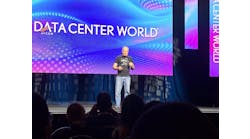Today we conclude our Data Center Executive Roundtable, a quarterly feature showcasing the insights of thought leaders on the state of the data center industry, and where it is headed. In today’s discussion, our panel of experienced data center executives weighs in on data center security and edge computing. Our panelists include Jeff Klaus of Intel, Amber Caramella from Infrastructure Masons and Netrality, Steve Dick of Emcor Enclosures and Sean Farney from KOHLER Power Systems.
The conversation is moderated by Rich Miller, the founder and editor of Data Center Frontier. Each day this week we will present a Q&A with these executives on one of our key topics.
Data Center Frontier: What are the top challenges in securing data center environments, and how do we address them in edge computing scenarios?
STEVE DICK, Emcor Enclosures
Steve Dick: It has been fascinating to watch the mindset for data center security evolve from physical and digital barriers, to observational recording of everything, to the latest zero trust approaches where everything needs to be explicitly and individually allowed. Traditional digital rules and locks can inevitably be overcome. The defense industry and datacenters have evolved in lockstep to arrive at the latest mindset where you observe and record everything, allow nothing until you permit something, and leverage artificial intelligence and machine learning to identify and mitigate abnormal behaviors.
Emcor is directly involved in the physical security of datacenters and colocation facilities. Our customers have found the value of leveraging our unique ability to customize and adapt our metal cage, rack/cabinet enclosures, and aisle containment systems to already-built facilities undergoing expansion or renovation, not just new facilities. Height, depth, width, PDUs, cooling, mounting, cable routing, and front/side/rear access points can all be adjusted without having to delay your deployment schedule. Key, combo, and biometric locks are available for all enclosures, cabinets, and cages.
Data center colocation and interconnect providers are optimizing floorspace footprint of datacenter cages and racks while ensuring cold-aisle/hot-aisle containment as the foundation to design, build and operate high-density computing environments at hyperscale.
AMBER CARAMELLA, Netrality Data Centers and Infrastructure Masons.
Amber Caramella: Data centers must deploy robust infrastructure designed to safeguard connectivity, carrier POE’s, power and cooling infrastructure, with multiple levels of secure systems. In choosing a data center operator, clients should consider security as an all-inclusive endeavor, with all aspects of facility infrastructure but also operations taken into consideration including standards for security and disaster recovery, facilitating compliance with HIPAA, HITECH, and other regulations.
In unmanned edge computing scenarios, there are additional risks to consider due to the devices spread across remote locations and lack of physical monitoring. These locations can be challenging to monitor which can result in increased cyber security concerns. In addition to digital attacks, physical security at the edge is a potential threat as well. Future considerations to address some of these concerns include designing monitoring systems that provide visibility such as cameras and remote management systems.
SEAN FARNEY, Kohler Power Systems
Sean Farney: Physical security in the service provider data centers – which is usually driven by the standardized controls that govern audit compliance – is rarely cause for concern. It’s the logical security – OSI Layers 2, 3 and 4- which are today’s greatest IT security challenges.
The risk in the Edge segment is that there are many smaller players with a handful of sites who may be more susceptible to compromise because they lack the scale and maturity of their MTDC and Hyperscale brethren.
Once the Edge market matures and is consolidated and absorbed by a global MTDC or two, this risk diminishes.
JEFF KLAUS, Intel
Jeff Klaus: In traditional data enters power, land, and construction costs still sit as the largest factors. With edge it can change the dynamic because you are deploying IT forward, so then it’s a matter of ensuring providing consistent power, environmental controls, and security.
A big part of our growth is providing light weight, remote management solutions for these edge environments.
Keep pace with the fact-moving world of data centers and cloud computing by following us on Twitter and Facebook, connecting with DCF on LinkedIn, and signing up for our weekly newspaper using the form below:








